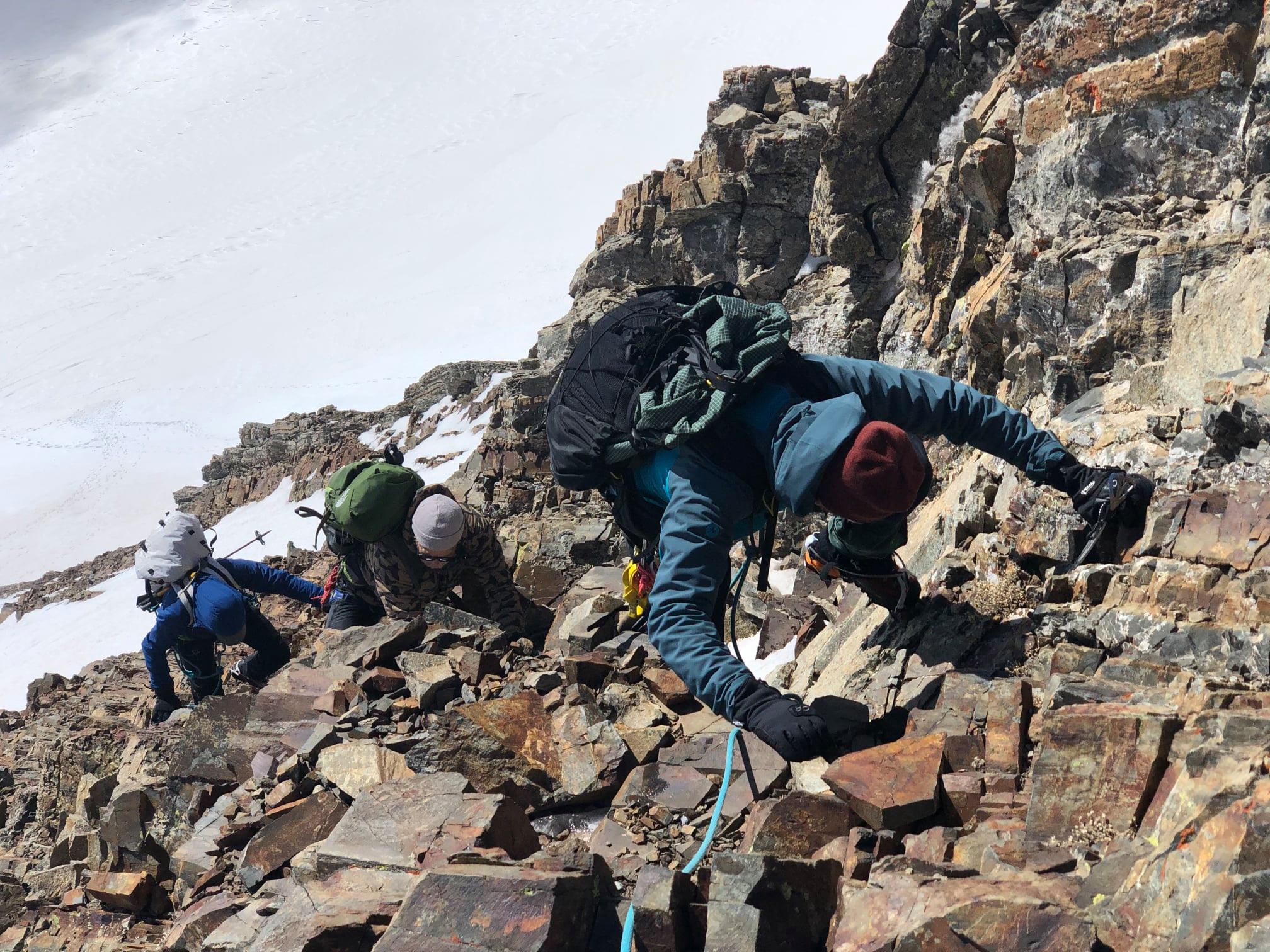With ‘extreme travel’ and ‘athletic adventures’ growing in popularity, amateur climber Ben Southan embarks on a three-day, post-lockdown climbing trip with 360 Expeditions, and finds himself tested to the limits – both physically and mentally.
Our feet planted firmly on the summit, the four of us shook hands and gazed out over the ocean of frozen peaks glittering in the midday sun. We stood at a height of 3,298 metres atop the Vignemale, the highest peak in the French Pyrenees.
The narrow ridge behind us plunged sharply on both sides. To our left was the headwall we had scaled via the Glacier D’Ossue and on the right the mountain dropped away down a vertical face to the Vallee De Gaube a thousand metres below.
In the swirling clouds of ice crystals whipped up by the bitter wind we stared into a shimmering halo of rainbow colours, our shadows stretching to touch the very centre of a solar glory suspended in the frozen air below. A Brocken spectre, a rare mountain phenomenon. God-shadows.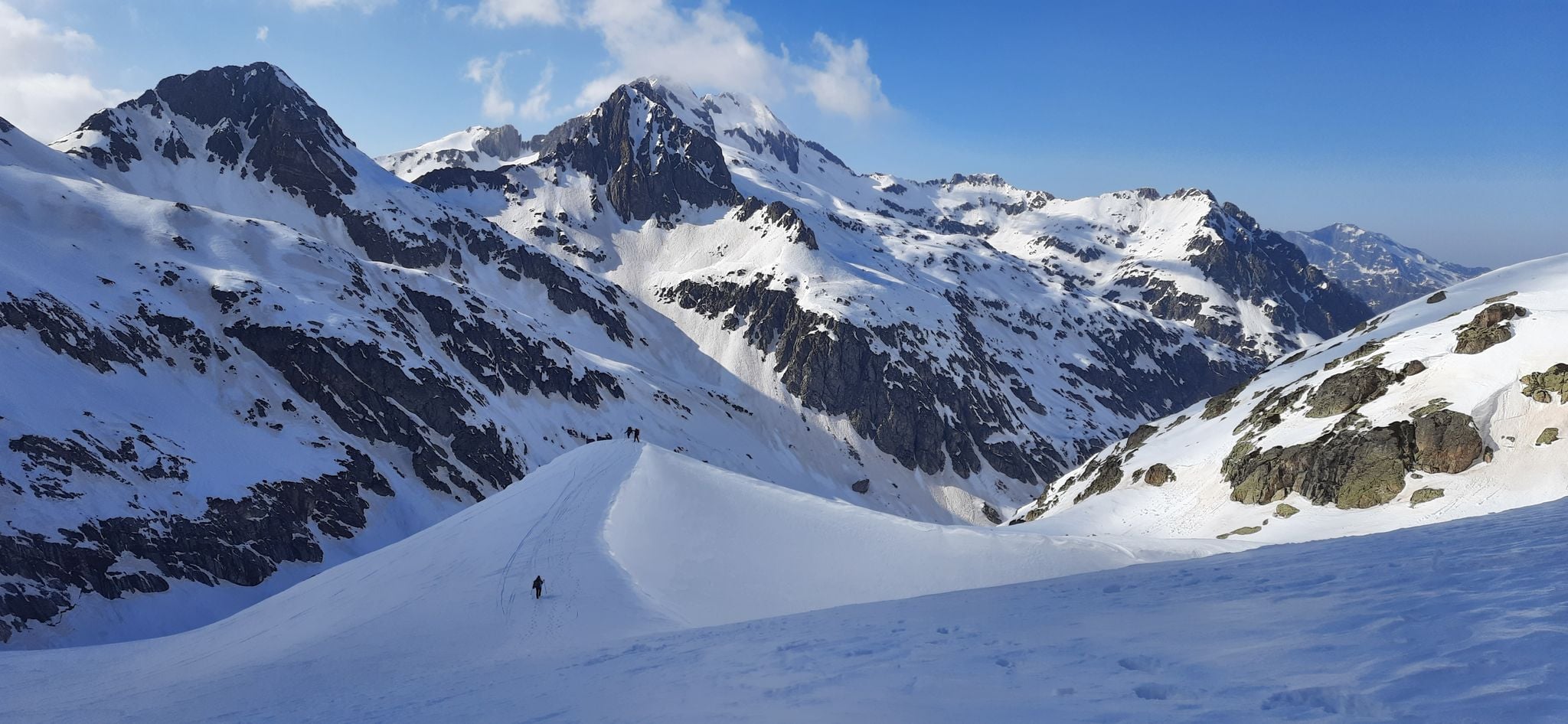
Looking for a challenge
Since the start of 2020 the scope of our lives has been significantly reduced by the restrictions imposed upon us all by the pandemic. For many, the goal has been to cope with losing loved ones, social isolation, depression, loss of purpose and identity, confinement and the stress of financial uncertainty is a harsh change that has been tough to bear.
Though hopefully for some of us these imposed limitations may have unwittingly served as a catalyst for positive change, forcing us to reflect deeply on our natures, examine our true values and explore our capacity to modify the narratives we have written for ourselves. Now more than ever I feel the need to seek connection with nature, to our world and the people and places in it.
I am lucky enough to live a few hours drive from the Pyrenees and a growing curiosity in winter mountaineering left me wondering how to gain an entry-level experience to a challenging
objective.
When a friend invited me to join him on a three day winter skills course in March 2021 run by 360 Expeditions, I seized the opportunity. I was keen to discover something new after months of unchanging routine and the mountains are an obvious arena to pit mind against body in the search for ones’ limits. I had my doubts as to whether I could hack it but I wanted to find out.
360º Expeditions is based in the UK and specialises in global adventure. Whether you’re looking to trek through the jungle to Machu Picchu, summit the seven highest peaks on seven continents, bike across Mongolia or simply climb for the weekend in France, they’ve got you covered.
But with cross-border travel restrictions the world is becoming increasingly difficult to navigate. However, as countries move from the amber list to green, opportunities for adventure closer to home on an affordable budget make the Pyrenees an ideal destination.
Starting the climb
We met Rolfe and Ben at Pont D’Espagne car park at 7.30am. Rolfe is 360’s Everest guide and Ben is an experienced mountain guide who joined us for fun.
The trail which carried us up the valley to the refuge at Oulettes de Gaube wound through a mixed forest of tall spruce, red stands of Scots pine and black Pyrenean pine rustling and creaking in the breeze.
We crossed bridges over stony brooks running cold and fast, passed frozen waterfalls hanging in glassy cascades on the rock face, our bodies warming to the work in the chill morning air. We carried 20kg packs full of everything we needed for three days on the mountain.
At various points on the trail we stopped to learn about avalanche risks, identify terrain traps, debris fields and how to increase the chances of survival in an avalanche. It all began to feel pretty serious. If you get caught in one your chances of survival decrease by 30 per cent every ten minutes you are buried.
Reaching the refuge at Lac de Gaube six hours later I dumped my pack on the floor and filled my flask with meltwater from the edge of a stream. I was tired. It was tough humping loads and we still had a way to go.
If you’ve ever wondered what it feels like to hike up a mountain in winter it is both beautiful and slow. The naturally jagged landscape is transformed by ice into smooth, rolling white undulations, pure and bright in the glare of the sun which beats down as you trudge for hours ever upwards; sometimes the ice is hard and the points of your crampons pierce the surface lending you traction, other times the ice has softened and you sink up to your knees, following laboriously in the kick-steps made by the person in front, taking it in turns to cut the trail for those who come behind.

You turn around to take in the view of the surrounding peaks, catch your breath, gulp some water, follow the progress of your tracks leading back down, let the distance covered motivate you for the next stage, turn uphill and continue to put one boot in front of the other. By the time we reached the col we had made 14km in nine hours with 1,200 meters of elevation and were exhausted.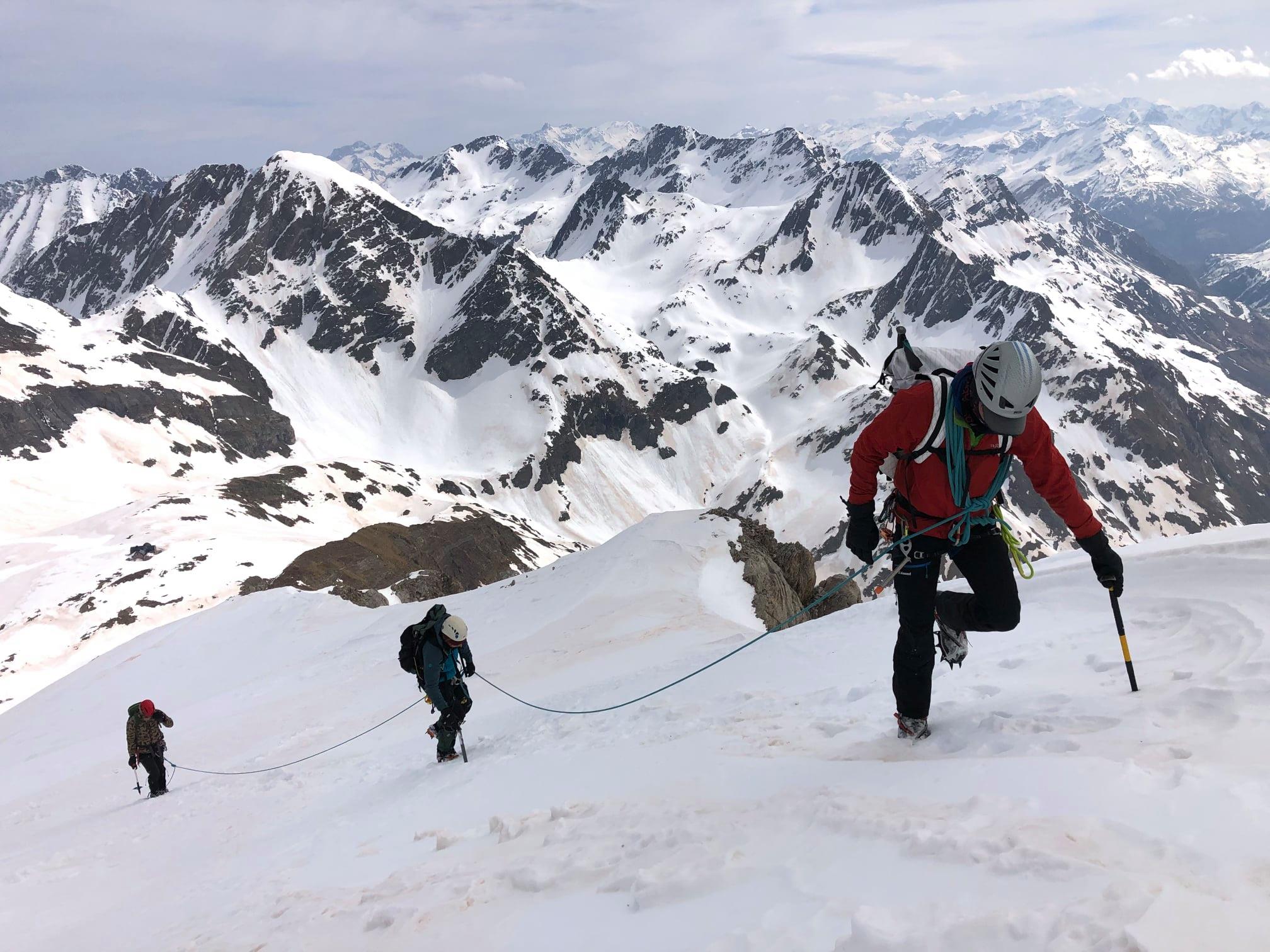
Winter survival training
That night we got a fire burning in the refuge de Bayssellance and melted snow to rehydrate after the long hike, cooked packs of dried food and refilled the water bottles for the next day. This was the same routine each night, a constant duty was to slip on a pair of rubber plimsolls and nip out into the night to gather snow for the pot.
A huge dust storm the month before had deposited tons of Saharan sand on the Pyrenees turning the snow into a marbled white and ochre patchwork, so it was important to dig down to take cleaner snow from lower in the pack.
Too much sand in your water could lead to kidney stones. These moments alone were special, stepping outside that remote hut in the gloaming of the light, misty mountains deepening into purples; later turning sharp and blue under the clear light of the moon as the landscape freezes hard and skittering shivers of ice blow snakelike across the surface of the slopes, softly musical, tinkling in the crisp, quiet air.
On our second morning I watched the sun rise and, after breakfast, Rolfe gave us an introduction to moving in the mountains. Soon we four were roped together making our way across the col to the foot of the Petit Vignemale, the little sister of the larger peak we had come to climb, which stands at 3,032 metres just beyond the refuge.
Tar-black alpine chuff hovered in the up draught and huge bearded vultures or Lammergeier swooped low overhead, their shadows sliding over the ice like dark ghosts. A bright ring of light known as a sun dog encircled the sun as we climbed higher and higher, moving in zigzags to reduce the angle of ascent.
We followed the ridge line until it narrowed and levelled off and we found ourselves standing on the summit. All around was space and air. The wind whipped at the flag Rolfe pulled from his bag and we took pictures before heading back down. We descended a few hundred metres to where the slope fanned out and spent an hour practicing self arrest techniques.
For those of you who don’t know, one climbs with an ice-axe in one hand. If you happen to slip and fall in that world of ice and rock you will start sliding pretty fast and end up in an extremely bad situation, often dead. So by rolling onto your front with your weight driving the pick of the axe into the snow you can slow yourself to a halt.
There are three common ways to fall:
- On your backside
- Head first onto your chest as you walk down hill. (This happens often as you are generally tired on the descent as it’s easy to catch a crampon spike in your gaiters.)
- Headfirst, downhill, on your back. There is also variation 3.1 where you begin sliding on your back without an ice axe and somebody passes you one as you fly by.)
 We learnt to assess the quality and safety of the snow pack, build several effective snow anchors to belay from and practise crevasse rescue. In the evening it was a case of smashing down another freeze dried packet of veg tikka masala, melting snow to replenish our supply of water and to get some sleep for the big day to follow.
We learnt to assess the quality and safety of the snow pack, build several effective snow anchors to belay from and practise crevasse rescue. In the evening it was a case of smashing down another freeze dried packet of veg tikka masala, melting snow to replenish our supply of water and to get some sleep for the big day to follow.
But that night I hardly slept, I was anxious and the harder I tried to wrestle my thoughts into submission the further sleep evaded me. I tossed and turned for hours and when the sun finally rose I felt awful, nauseous.
The final ascent
The four of us began to pack for the day but I couldn’t eat and it was an effort to strap into my crampons and head out. Stepping into the light and breathing in the cold air I could feel my muscles begin to wake, and as we moved downhill my head cleared. Rounding the corner at the base of the glacier things clicked into place. I felt focussed.
The hike up the glacier took several hours and I later learned we had crossed two crevasse without knowing it. Nobody talked much, pausing occasionally to eat a snack and glug down some fluids.
Upon reaching the foot of the 80-metre headwall leading to the summit I studied it wondering which route we would ascend. It stood at an angle of 60 degrees and has the alpine grade of PD+ (Peu Difficile) or AD (Assez Difficile) in winter.
Rolfe found the route and led us up it. The new sensation of climbing with a backpack, ice axe and crampons made me feel clumsy and unsure on the mixed rock and ice, but when we reached the ridge-line the views became spectacular.
It felt like such an achievement. I could see several skiers making their way up the glacier below but it felt so far removed from anything I’d experienced before standing on this windswept peak in the middle of a mountain range that I couldn’t comprehend it when Rolfe suggested we get moving as things would get busy soon. It was a Saturday after all…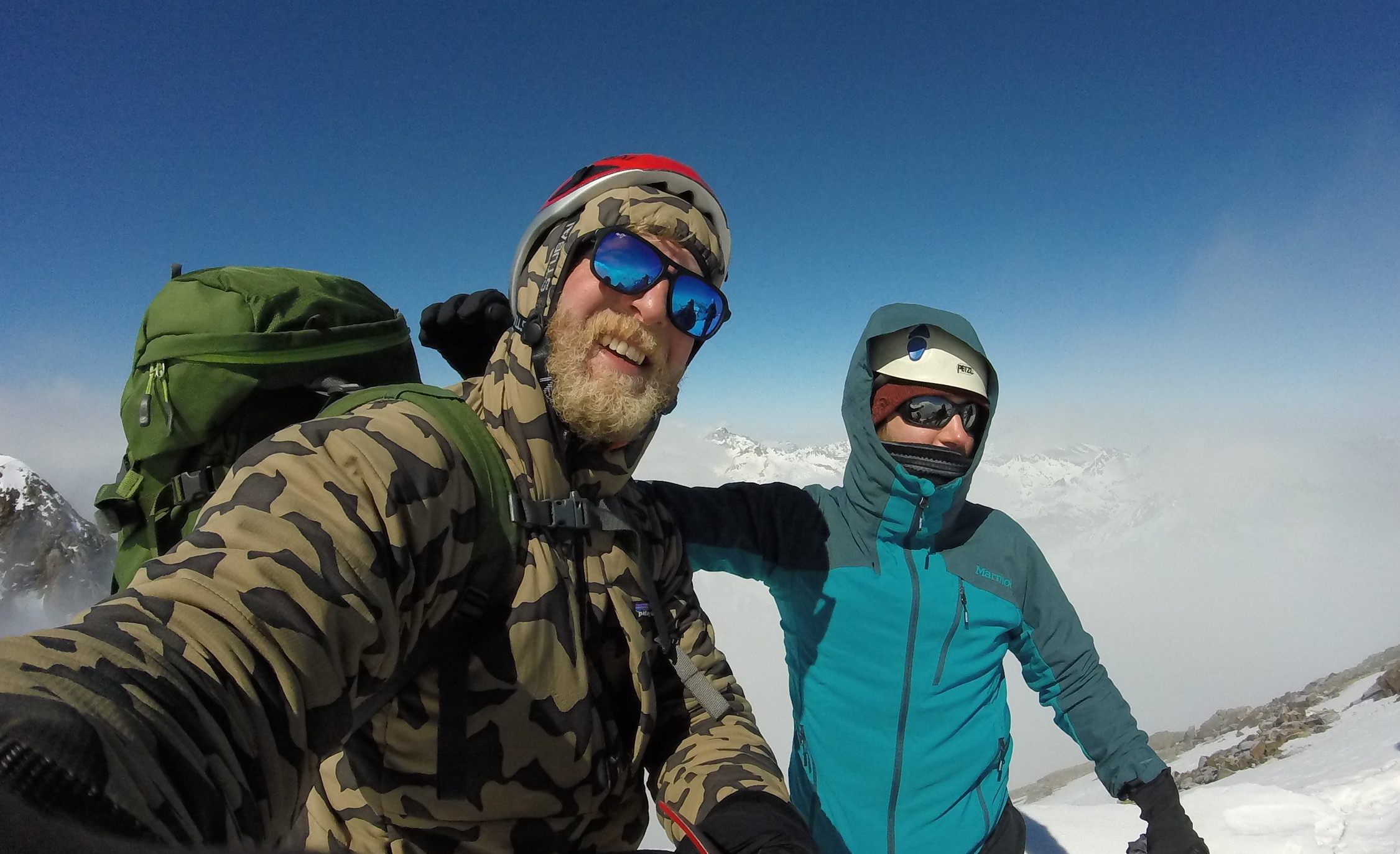
Going down and facing fears
We reached the glacier by down-climbing the same route and began our descent. My spirits had lifted, we had achieved our goal. But the saying goes that the summit is only halfway point, and for good reason.
Further down the glacier we struck out to the left of the path we had walked in on and instead traced a line below the foot of the cliffs to avoid crossing the crevasses which would have become less stable in the midday heat.
The path began to drop steeply until it became too sharp an angle to walk down so we found ourselves making an exposed traverse across a 65-degree slope high above the glacier. I was pushed to the edge of my comfort zone.
Ben went first and I followed, behind me came Tom and Rolfe. My heart beat hard. It felt extremely exposed, but these situations focus the mind, forcing us to ask only important questions such as: will the next foothold collapse when I step on it? But that can only be answered by stepping forward, because you must. It does not collapse.
You ask the same question again and repeat. Plunge the axe into the snow, test each foothold before weighting it, squash that insistent voice which threatens to sap your resolve; this part of you cannot be suffered to exist.
Trust in the people you are tied to and uphold the faith they put in you. Let the stronger parts of you breathe, think logically, calmly, suppress fear, celebrate the aching of your muscles and the strain on your nerves, allow the most useful parts to rise to the surface. I was amazed at the confidence of our guides. They were the real deal.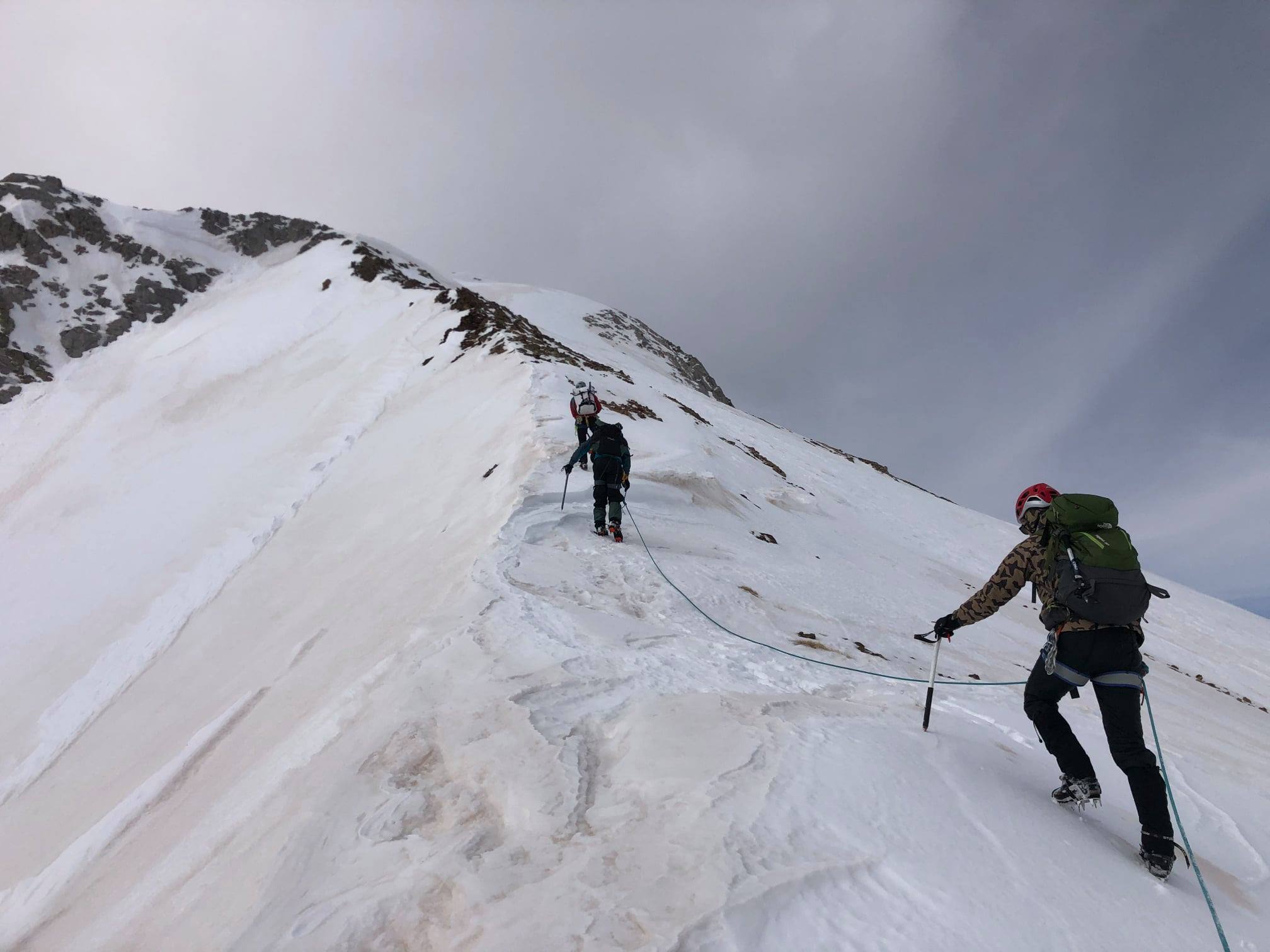
Why embark on an extreme travel experience?
Looking back I had understood that it would be physically challenging but had not prepared myself for the mental intensity of the exposure. It was psychologically draining. The height, the scale, the precarious conditions, the uncertainty and vulnerability were tiring.
I had no real frame of reference to draw upon other than a few trips to the mountains that winter to complete easy ascents on snowshoes with friends.
Perhaps these extreme experiences reframe our reality, lend us perspective and show us our true value in relation to life, a shortcut through the maze to accessing a purer mode of thought, defining our limitations through challenge and adversity, a clarification process to determine priorities and gain of control of our thoughts, worries and insecurities, if only for a short while.
As we made the hike back out I had hours to reflect on the experience and, at the time, I felt I had found my answers. It was a joy to plough downhill knee-deep in powder feeling grateful for the opportunity to hike and climb my body up a mountain but I was equally aware of having put that privilege at risk simply by being there.
The mountains in winter are formidable and require respect. Mistakes can mean death. But they are undeniably some of the most beautiful places on earth, wild, mysterious, ever changing landscapes rich in wonder and charged with the raw power of nature.
For several days after I was balanced and full of life. I had taken a dose of experiential medicine and felt the benefits, but how long does a dose last? When asked if I would pursue winter mountaineering further I hesitated, unsure of the answer. I suppose I’ll find out by next winter. After all, they say the best alpinists are the ones with the worst memories…

